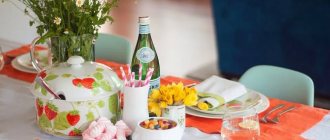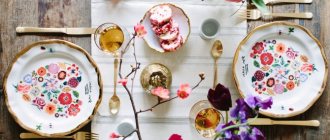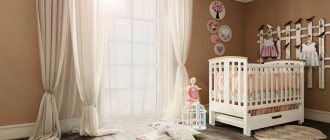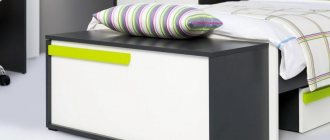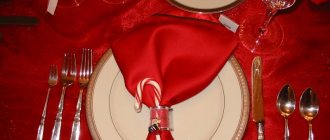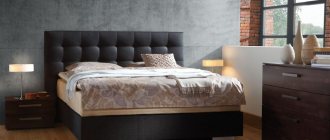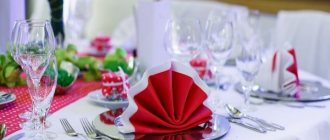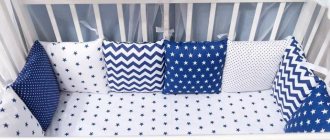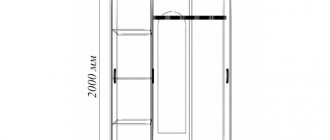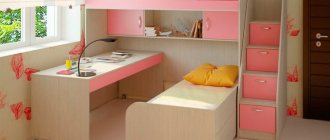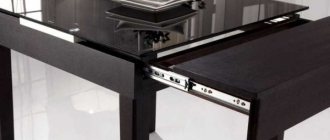Table setting items are of great importance: they help to serve a certain dish stylishly and beautifully and create a festive atmosphere. Knowing how to set a table correctly is important for both owners and employees of the restaurant business, as well as hostesses who want to make a positive impression on guests. One of the main items for serving dishes are plates. It is necessary to know the types of plates for table setting, their correct location and names.
Table setting items are of great importance: they help to serve a certain dish stylishly and beautifully and create a festive atmosphere.
Three pillars of the everyday table
The minimum set should include three types of table plates - for first and second courses, as well as dessert. They can replace additional dishes if there are none in the house.
Dining rooms
Depending on the depth and size, dinner plates come in two types:
- Deep - with a capacity of up to 500 ml, with a diameter of 24 cm. Used for serving first courses, as well as for some hot dishes containing sauces and gravy.
- Small - the most common and popular plate with a diameter of 24 cm, it is used for serving main courses and hot appetizers: fish, meat, poultry.
These two types can be classified as mandatory, but it will not be difficult to replace them with other varieties. Moreover, the classic deep dinner plate is less popular today; it has been replaced by deeper plates with a smaller diameter and less pronounced sides.
Soup
Which plate should I put for soup or borscht? Of course - soup, but there are several types, differing in volume, depth, shape.
Deep portioned soup bowls hold 0.5 liters. The standard diameter is from 23 to 27 cm, the sides are wide, slightly beveled to protect the table from drops. In such dishes, soups cool faster and look beautiful - the ingredients are clearly visible over a large area.
Semi-portioned soup bowls have a volume of 0.25 liters and a diameter of 20-25 cm, suitable for children and those who prefer not to overeat.
If you don’t like the large diameter, you can choose a modern option - a deeper plate with a smaller volume, high and strongly sloping walls without pronounced sides. In this case, the soup will remain hot longer.
As an alternative for soups, people choose portioned tureens, bouillon bowls, bowls and even some salad bowls.
Dessert
Dessert serving plates have a diameter of 19 to 21 cm. They come in two types:
- Small – flat ones are intended for portion serving of pastries, cakes, muffins, mousses and other desserts.
- Deep - with a recess of 2-3 cm, used for serving desserts with sauces, sweet cereals, berries and fruits.
Dessert plates can be included in a set of tableware, and are also often included with tea and coffee sets. It is not difficult to find them separately - in sets of 6 pieces and individually.
Result:
In our article, we explained which cutlery should be used for serving, in what order and why. We took as a basis the table setting and etiquette that is used in Russia and Europe. But you can still come across slightly different serving nuances, this will not be a mistake, these are just the peculiarities of the country’s etiquette that have historically developed this way. For example, in France they place forks point down, which is how they want to show that they are positive because... They believe that if the sharp tips of the fork are up, it means a threat and a hostile attitude of the owners.
In addition to regional nuances of etiquette and serving. Servings come in different types, i.e. table setting for dinner, lunch, breakfast. And our article will help you on how to form the basis for any table setting, and because... We are preparing a table setting for receiving guests at home, we recommend adding the necessary elements yourself to highlight the style and taste of the hostess.
If you have any questions, feel free to write to us and we will help you.
Extra dinner plates
In addition to the main plates, there are many interesting types of narrow purpose ones. They will decorate the table and make eating more convenient. Some are required by etiquette, others will only be required for certain dishes.
Snack bars
Snack plates are designed for serving cold appetizers to the table. They are flat with a diameter of up to 32 cm. The purpose depends on the diameter:
- Large ones are used for table setting, serving cheese, cold cuts, salted and smoked fish, sandwiches, and tartlets.
- Small ones - with a diameter of 20-22 m - are used for portioned snacks, served to each guest.
The number of large appetizer plates does not have to be equal to the main types. Design may also vary. If the set of dishes does not include a snack bar, it is easy to find a suitable option among the glass.
Wildcard
Place plates, or under plate guards, are designed to protect the table from hot dishes, drops and food crumbs. They are placed on the table first, and on top are dishes with food: a dinner or snack plate, a tureen, a portion pot. During the change of dishes, plate holders are not removed. The exception is if you get dirty. It is not customary to eat from them, so there is no need to rush into salads and snacks.
Plates can be part of the service, but often they have to be purchased separately. If you cannot find dishes that match the design, it is recommended to choose transparent glass. Today, instead of placemats, table napkins made of cork or polymers are used.
Pirozhkovaya
Pie plates are distinguished by their flat shape and small diameter - 18 cm. They belong to portioned serving utensils and are used for serving baked goods, pies, and sandwiches.
In addition to its main purpose, this small plate is used for table setting instead of snack bars, as a stand for pots and cocotte makers (when there is little space), instead of dessert dishes for pastries and pies.
Bone plate
Bones are found in meat, fish, fruits and berries. Also in the process of eating there are other wastes: peels, husks, shells. To collect everything inedible, there are special plates for bones with a special shape.
They are not round, but crescent shaped. This shape simplifies serving - the container for bones is placed as close as possible next to the dining table, almost merging with it. There are even hanging options that attach to the side of the dinnerware. Did you know about this decision? Most people are not aware, although it was used back in the 18th century.
Fish
One of the least common and rarely used, it is undeservedly deprived of attention. A classic fish plate has an oval shape - 24-25 cm wide and 33-36 cm long. It’s easy to guess that the oval shape is determined by the dimensions of the whole fish carcass, for serving which this dish was designed. Do not confuse with herring, they have different purposes.
Fish plates are portioned; they serve baked, fried, boiled fish in whole carcasses or large pieces. With side dishes, vegetables, sauces. It's difficult to find an alternative. They are also convenient for some meat and poultry appetizers.
In addition to the classic oval shape, there are shaped plates on sale that emphasize the purpose. For example, in the shape of a fish with a head and tail.
For spaghetti
For pasta connoisseurs, there are special recessed plates with wide, flat brims that make it easier to wrap spaghetti on a fork and protect the table from sauce droplets. It looks very much like a hat with a brim. Some models have recesses in which the fork rotates.
The diameter of the pasta plate ranges from 20 to 33 mm, but the usable volume is usually no more than 250 ml. There are options with additional recesses for sauces. Available with perforated inserts that eliminate excess liquid. Sold individually and in sets.
Egg
From the name it is easy to guess that the egg plate is designed for serving scrambled eggs, boiled eggs and omelettes in portions. The form depends on the purpose.
The standard diameter of a small plate for scrambled eggs is 20 cm. In the classic version, it has a flat bottom and pronounced sides that rise almost vertically above the base. But in the modern variety there are plates of different shapes - from those with practically no sides to deep ones, more reminiscent of salad bowls.
A plate for serving boiled eggs is a beautiful alternative to a miniature stand for soft-boiled eggs. In stores you can easily find beautiful plates designed in the shape of a broken egg. They may have recesses for sauces.
This also includes dishes for serving several eggs. The grooves help to arrange the eggs beautifully, preventing them from rolling into one pile, and prevent splitting.
Napkins
The napkin has its own sign language, so how you place it depends on the further behavior of the waiter, but let's look at it one by one.
The napkin can be served decorated or standard.
The design is of course beautiful and impressive, but it is believed that the less the waiter touches the napkin, the better, and the design takes time and effort, so don’t be shy about just putting it down, it’s quite normal. An easy and quick way to decorate it beautifully is this napkin ring - fast, beautiful, convenient.
Using a napkin
Yes, yes, the napkin still needs to be used correctly. If the feast is very long, in this case the napkin can be completely opened and placed on your knees, but in most cases it is placed on your knees, folded in half with the fold facing you. You wipe your hands on a napkin only under the table, and if you need to wipe your mouth, you need to bend one edge of the napkin and carefully bring it to your mouth with the inside of the other half and blot it around your mouth, under no circumstances rub your face with it, get it wet!
Where to put the napkin and what does it mean?
The behavior of guests and waiters will depend on where you put it. If you get up from the table, then you need to put it in the place where you were sitting - this will mean that you will return, if you put it on the table, then this means that you will not return and have finished your meal. If you are at a banquet and the host or hostess gets up from the table and puts a napkin on the table, then it’s time to leave. The napkin does not need to be crumpled or neatly folded, just place it as you took it from your lap.
Serving plates
To serve snacks on the table, plates are also used, unlike portioned ones; their number should not coincide with the number of guests. In some cases, only one item is needed.
Herring girl
The herring bowl is an oval dish with small sides and is intended for serving lightly salted herring or other fish. The length of the herring bowls is 22-26 cm, width – up to 14 cm. In addition to the oval shape, you can find a rectangular one – a modern answer to the usual classics. For lovers of exquisite tableware, there are fish-shaped ones .
Herring boxes are made from materials that do not absorb odors, juices and oils. The most practical are glass. Often a herring plate is included in a dinnerware set. This option is also sure to be presented in collections.
Menazhnitsa
One of the most useful assistants in table setting. The menagerie is a plate divided into several segments by additional sides. Salad bowls save a lot of space by replacing several salad bowls at once.
They are convenient for serving all kinds of snacks: mushrooms, olives, pickles. Several types of salads or sauces, appetizers and desserts look beautiful in them. Menazhnits come in different sizes and heights - from small (plate type) to deep (salad type). Segments are made in regular and irregular shapes, as well as in the form of a spiral.
Transparent glass bowls look impressive, demonstrating the dish in all its glory, and can be combined with any utensils. It will also not be difficult to choose a suitable option from ceramics, porcelain, or stainless steel.
Dishes
A dish is a flat plate with a large diameter - from 30 cm. Sets may include dishes with a smaller diameter - from 24 cm, but they are always flat and differ from table plates. Cold appetizers, beautifully arranged cheese and cold cuts, festively decorated hot appetizers, pilaf, and baked vegetables are served on the common table.
Dishes are not only round, but also oval and square. Oval ones are convenient for serving poultry and meat in whole pieces. Square ones are compactly placed and suitable for almost any task.
Sockets and bowls
One of the smallest served plates with a diameter of 8-10 cm. They can be used in the process of setting a common table or as portioned utensils. The outlets serve jam, honey, sauces, and some desserts. It is not prohibited to use them for serving olives, small mushrooms, and marinades.
You can expand the use of outlets by serving ice cream, mousses, and jellies in them. But for these purposes there is another type of cookware - bowls.
Kremanki are deep plates with a diameter of 9 cm with a stem. They serve desserts and portioned salads.
Drinkware
tableware for tea drinking
Stacks, glasses, and wine glasses are used to serve drinks to the table. They differ in shape and volume. You need to know what drinks the glasses are intended for and take this into account when setting the table.
- The classic glass is used to serve sparkling wines. It is elongated in shape. Its volume is 120-200 ml. It should be cooled before filling.
- A wine glass with an increased volume has a slight difference from a classic container. Its neck is slightly narrowed. It is intended for refined sparkling wines. It is also cooled before filling. The drink is poured into the glass no more than 2/3 full.
- A glass with a narrow stem is used to serve white wine. Its bowl is slightly elongated. Its volume is 180-260 ml.
- More open and spacious wine glasses are designed to serve different types of red wines.
- Cognacs are served in classic glasses.
Liquor glasses, shot glasses, and beer glasses can be used. It all depends on the wishes of the invited guests and the wishes of the event hosts themselves.
What materials are plates made from and what to choose?
Different materials are used to produce plates. When choosing, be guided by the purpose and operating conditions of the cookware. Be sure to consider microwave compatibility and dishwasher safety if applicable. For everyday use you need practical cookware. For special occasions, you can choose a more beautiful and festive one.
Porcelain, faience, ceramics
All these materials are based on clay. The difference between them is in the firing method and modifying additives.
- Ceramics is a mixture of clays with mineral additives, which must be fired and covered with glaze. The tableware is thick and massive and retains heat for a long time.
- Faience is a cheap porous material, products from which are coated with a low-melting glaze and fired once. Glaze makes surfaces bright and beautiful, but tends to chip. Earthenware plates are fragile, although not thin, they split from blows and break.
- Porcelain plates are light and thin, but durable due to the absence of pores. The most expensive bone china , to which bone powder is added for strength and improved appearance. Real porcelain allows light to pass through. Professionals recognize it by the characteristic sound when tapped.
- Semi-porcelain differs from porcelain in the firing technology - it is not fired until completely sintered. The products are not as durable as porcelain, but stronger and more beautiful than earthenware due to less porosity.
Real high-quality porcelain shines through in a thin layer and is white with a slightly bluish tint. Ceramics and earthenware do not allow light to pass through and make dull sounds when tapped.
When choosing, consider not only the material, but also the type of decoration. Gilding looks impressive, but such dishes are not suitable for everyday use - they cannot be put in the microwave, and the paint from hot water and detergents loses its shine and wears off. The most durable underglaze painting is applied before glazing and baking.
Glass of different types
We have already talked in detail about what types of glass plates are made from and which is the most practical and convenient on our website “Types of Tableware”. Let's take a brief look here.
For the manufacture of high-quality glassware, sodium-lime, sodium-lime-potassium, lead, zinc-barite and borosilicate glass are used. But often, instead of technical names, manufacturers use names that are more understandable to the consumer.
Modern glass plates are transparent and made of a dense mass. Utensils for every day are made from tempered glass , which is not afraid of frost and high temperatures, and is suitable for microwaves.
If the manufacturer indicated impact-resistant glass in the manufacturing material, this indicates that the composition contains polymers that enhance strength and prevent sharp fragments when cracked.
Opal glass is obtained by adding spar, dolomite and bone ash; it is very thin, but durable and practical. Opal tableware is translucent, matte, and beautifully reflects light, reminiscent of the stone for which it is named.
Glass porcelain and glass ceramics
Modern materials obtained by crystallization of multicomponent glass in the presence of fluorides. In appearance they resemble thin and elegant porcelain or thicker and more massive ceramics. The materials are similar in composition and manufacturing method, but different manufacturers develop their own technologies, achieving slight differences.
Glass porcelain and glass ceramics are practical, impact-resistant, resistant to temperature changes, microwave and dishwasher compatible, and scratch resistant. The surface is smooth, does not absorb juices and does not stain. A big plus is that there is no glaze, nothing to chip off.
Tree
Wooden plates attract lovers of eco-style; they are made from both natural wood and pressed wood with the addition of substances that increase resistance to moisture. The tree is suitable for serving bread, pizza, buns, other dough products, and cheese. Oily and moist products will leave marks and odors if the wood has not been properly treated.
Wooden dishes and plates are made from ash, oak, cedar, ash, and bamboo. To increase resistance to moisture, wood is impregnated with vegetable oils. This also includes serving boards - a stylish alternative to plates.
Metals
Metal plates are available in stainless steel and sheet aluminum. First of all, such dishes are intended for hiking and are often located in sections for tourists in online stores. It also makes sense to consider metal cutlery for small children and the elderly - it is safe even if it falls on a tiled floor.
The downside is that it is not suitable for microwaves, and the appearance is not for everyone. The metal walls heat up from the food, while the contents quickly cool down.
Plastic
Only reusable food grade plastic is suitable for the production of tableware. Look for the markings: PP (PP) and 2 (HDPE). When studying the characteristics, it is first of all important to look at the minimum and maximum operating temperatures and make sure that it can be used for storing food in the refrigerator and heating food in the microwave.
Plastic dinnerware is not very popular when it comes to the home. Rather, it is suitable for camping conditions, trips to nature, and in the country. When choosing, it is recommended to give preference to high-quality dense plastic.
Care
Over time, porcelain loses its shine. It is washed with a soft sponge in water with the addition of salt or soda. Afterwards, wipe with a cloth towel soaked in vinegar or citric acid. Add a few drops of ammonia to warm water.
Ceramic plates can be washed in the dishwasher. Salt and vinegar will do a great job of eliminating unpleasant odors. Do not use metal brushes.
Glass utensils are washed with detergents. Then wipe dry so that there are no stains or streaks left. To add shine, use blue or alcohol.
What kind of plate can be put in the microwave?
It is convenient to heat food in plates, but this can only be done if the material is microwave compatible. The best way to find out about compatibility is to review the information provided by the manufacturer.
What does the marking :
- Microwave safe - suitable for heating and cooking / But if this phrase is crossed out, then the manufacturer reports that the plate is incompatible with microwave ovens.
- Not recommended microwave - not recommended.
- Plastic marked PP is not suitable for hot food and is intended exclusively for storage at room temperature and in the refrigerator.
The following dishes should not be placed in the microwave oven:
- made of metals;
- with decoration using dyes containing metals (gilding, silvering);
- crystal;
- some types of porcelain and ceramics (intended exclusively for serving).
Suitable for microwave:
- heat-resistant and tempered glass;
- glass porcelain and glass ceramics;
- heat-resistant porcelain and ceramics for ovens;
- Microwave compatible plastic;
- silicone
Popular earthenware plates can be heated in the microwave, but for long-term cooking it is better not to use them, since the porous mass is prone to cracking.
Where to start
When planning to set the table, you must follow the following steps, then the setting will be appropriate, convenient and in accordance with the rules of etiquette.
First, you need to carefully consider the menu. The need for certain items on the table will depend on this.
Secondly, you should find out the number of guests. This will help avoid unnecessary cutlery on the table and will not disrupt the harmony.
The third preparatory step will be checking the cutlery for cleanliness and integrity. It is unacceptable to set the table with unpolished cutlery or chipped plates. Forks, spoons, knives must be free of rust and not bent. Before serving, the dishes are wiped with a damp sponge, then thoroughly wiped dry, since drops of water on the dishes are considered bad manners.
And the last thing is the tablecloth. It can be made of absolutely any material, but in no case is it covered with oilcloth. Of course, the tablecloth should shine clean and be well ironed.
Not only round – which shape is more convenient?
The word plate is associated with a round shape, but traditions can and should be broken. In addition to round ones, it is easy to find original square, almost oval, rectangular, triangular and shaped plates on sale.
The square shape is gaining popularity and no longer seems outlandish. Square dishes are chosen by people who do not like to be like everyone else and prefer to stand out in everything.
Square plates are more compact and look beautiful on the table. In the case of serving, it is easier to arrange them closer to each other and with the right approach there will be no visual clutter.
A few rules
all cutlery must be arranged in a consistent manner
Before arranging dishes and cutlery, you need to check that they are intact and clean. This means that they must be free of cracks or chips, plaque or rust. Cutlery should not be bent.
Even the most stylish tableware should be wiped clean from dust and water marks . To do this, wipe it with a damp towel. Then the dishes are polished with a dry, clean cloth.
All cutlery and accessories are arranged in the same order. It is acceptable for the participants in the feast to have different utensils if the atmosphere is quite informal. You just need to remember that each guest must have all the cutlery from one set.
using vases with fresh flowers when setting the table
To set the table beautifully, you can use a wide variety of elements. A significant part of them is not used daily at home feasts. However, these elements will be needed when a festive dinner or banquet is organized.
Decorative and souvenir types
Plates are used not only for their intended purpose, but also as a decorative element. Painting, photo printing, beads, and other techniques are used for decoration. Beautiful decorative plates decorate the walls; they are placed in cabinets on shelves in special stands.
Artistic and decorative plates are made from clay, ceramics, porcelain, colored glass, wood and paper pulp (papier-mâché).
You can’t do without plates, but you don’t have to buy all types; use interchangeable ones so as not to clutter your cabinets with unnecessary utensils.
How to cover: stages
Setting the table takes place in strict sequence. Earthenware and porcelain dishes are placed first. Next comes the arrangement of cutlery. If you need glassware, then her turn is last. Do not place all cutlery and dishes at once. First, the cutlery for the main course is prepared. After the dishes for the first are removed, plates are placed for the second or decoration for dessert.
Beautiful table setting.
Laying out the tablecloth
Preparation for meals begins with the tablecloth. Clean, neat, well ironed, it is laid on the table with an allowance downwards of 25-30 centimeters. You should not take a tablecloth that is too long, as when it falls to the seat of the chair, it will interfere with the guest. Usually fleece or other soft fabric is placed under the tablecloth. This is necessary so that the cutlery does not make a loud sound when it comes into contact with the table.
Oilcloth over the tablecloth is excluded. It is allowed to use a Teflon tablecloth. This coating will protect the table surface from spilled drinks and greasy stains. The Teflon tablecloth is easy to clean with a damp sponge. In some cases, etiquette rules allow the use of under plates or runners (narrow strips of fabric located in the center of the table).
Laying out the plates
The next step is to arrange the plates. They should be located at the same distance from each other, at a distance of a couple of centimeters from the edge of the table.
Example of plate layout.
The optimal gap between the dishes should be at least 50 cm. This way, the participants in the feast will not disturb each other and will feel comfortable. The same table set is provided for each guest. The amount of utensils needed depends on the type of meal. So, if it’s a simple snack, then one plate is enough, but for lunch and dinner you already need several plates, of different types.
If you need to place two plates, then the smaller one is placed on top of the larger one.
When serving soup, a deep soup bowl is placed on a stand plate. As a rule, salad and dessert plates are placed to the left of the main ones. A small bowl can also be located here.
Putting cutlery
Cutlery is placed to the left and right of each plate. According to etiquette requirements, spoons and knives should be on the right, and forks on the left. When serving, you need to pay attention to the fact that the cutlery should be turned towards the table with its concave side. The knife is located on the right, with the blade towards the plate. The spoon should be to the right of the knife, and the fork should be placed to the left of the plate. When planning to serve soup, you should place a soup spoon on the table. It is located between the appetizer and fish knife.
Only those items that will be needed during meals should be on the table. Excess will get in the way and look out of place. Usually, a knife, spoon, fork and dessert spoon are enough to set the table for a home meal.
We put glasses, wine glasses, glasses
The glasses are arranged in a row from largest to smallest. A wine glass is placed to the right of the plate. There is no need to place a lot of glasses or glasses, as this will cause inconvenience to the invited guests. In addition, the table area will be cluttered. Let there be only those utensils on the table that are really necessary during the meal.
Option for placing glasses.
Lay out napkins
According to the rules of etiquette, both textile and paper napkins must be present on the table. They are selected based on the overall design of the table.
There are a lot of ways to lay out napkins. For example, for breakfast you can simply place a napkin on the side of the plate. But most often they are placed under appliances. You can also put a napkin on a plate.
To surprise your guests, you can fold the napkin in some intricate way. This technique will decorate the table and add zest to the table setting.
Decorating the table
Table decoration has no clear limits. Of course, you shouldn’t overload your holiday table with decor, it will seem bad taste. Also, the decoration elements should correspond to the occasion of the meal: if it is a New Year's table setting, then pine cones and spruce branches on the table will come in very handy.
Vases with flowers, candles in elegant candlesticks, creatively folded napkins - all these are fashionable ideas for table decoration.
Table decor in Easter style.

